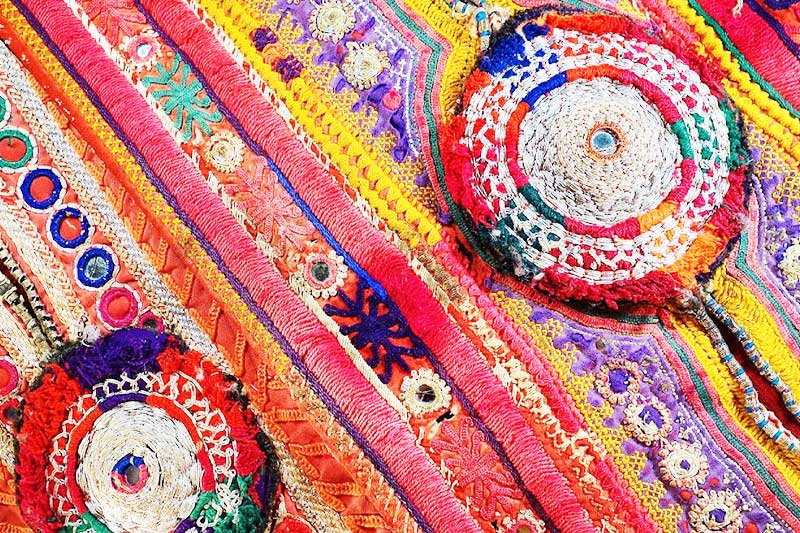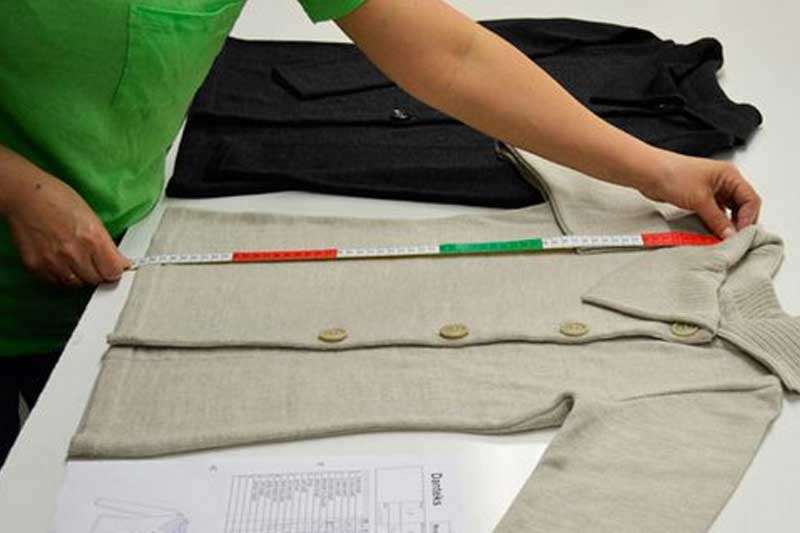Textile Industry in India: An Overview
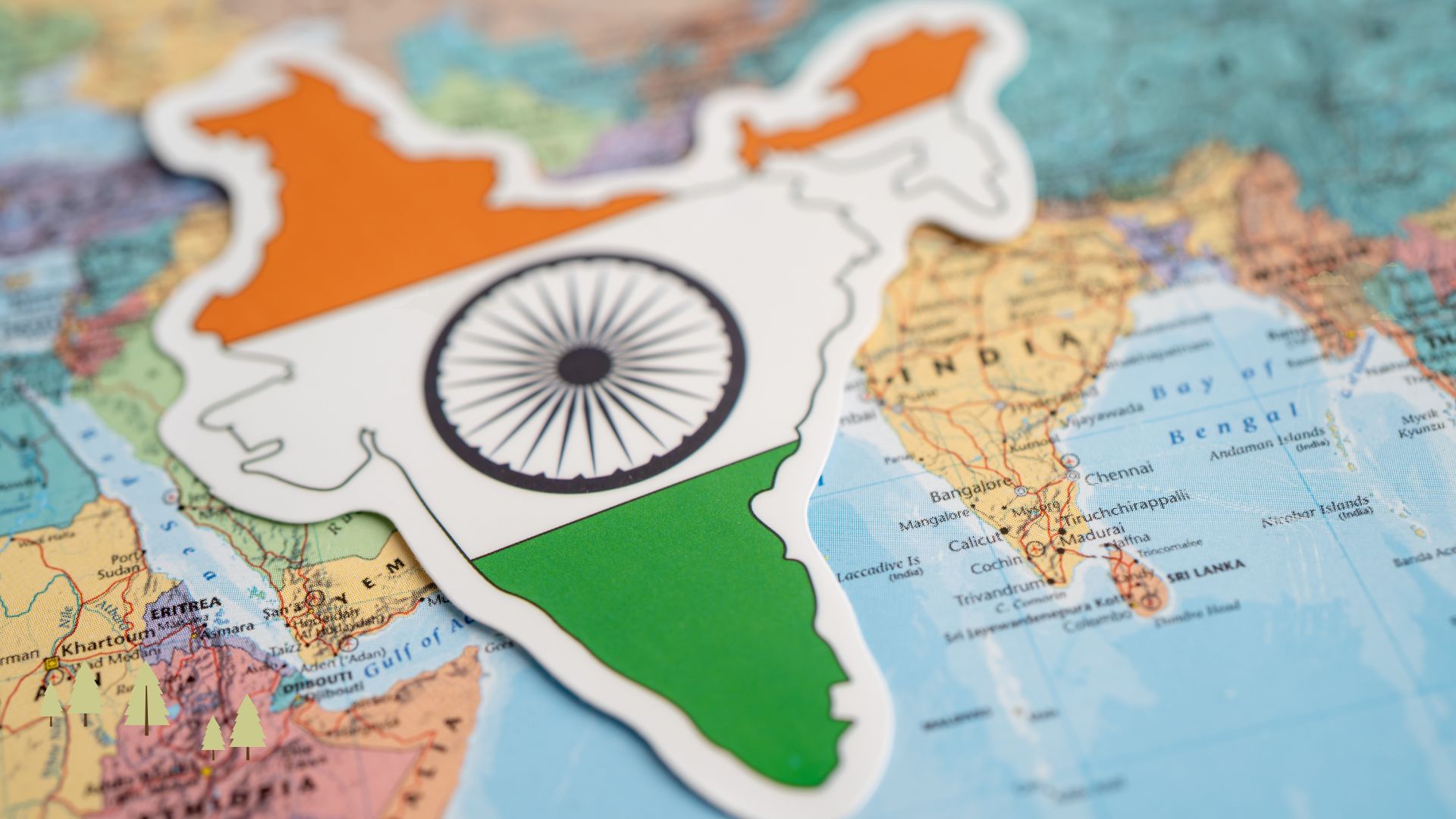
The Indian textile industry is one of the largest in the world, accounting for 4% of the global textile and apparel trade.
The industry dates back many centuries and is tremendously diverse, with hand-spun and hand-woven textile industries on one end of the spectrum and capital-intensive modern mills on the other.
With more than 65 million employees in the direct and associated sectors, the Indian textile industry contributes 2.3% to the country’s GDP, 13% to industrial production, and 12% to total export earnings.
The textile and apparel exports in 2022 grew to US $44.4 billion in FY’22 compared to US $29.9 billion in FY’21, marking an increase of 41% YoY. Recent trends in textile industry, significant government reforms and increased consumer demand primarily drive revenue growth.
History of Textiles in India
With the first mill established near Kolkata at Fort Glastor in 1818, successful large-scale textile production began in 1854 in the city of Mumbai with the establishment of “Bombay Spinning and Weaving Company” by “Cowasjee Nanabhoy Davarthe,” a Parsi businessman and banker, making it the first successful textile mill of India.
Now 168 years later, India is the second-largest textile producer in the world, with more than 3400 textile mills and an installed capacity of more than 50 million spindles and 842,000 rotors.
Major textiles produced in India
Various crops are used to produce the raw materials for the country’s textile industry. The fundamental strength of the textile industry in India is the presence of revolutionary new technologies and its strong production base of a wide range of fibers and yarns, from natural fibers like cotton, jute, silk, and wool to synthetic/man-made fibers like polyester, viscose, nylon, and acrylic. India is the largest producer of cotton in the world and one of the leading producers of jute, silk, and wool.
Let’s have a glimpse at the significant natural textiles produced in India.
Cotton
India is the biggest producer of cotton, accounting for 22% of the total cotton production in the world. More than 11.7 million hectares of cotton in India are grown, compared to 31.2 million hectares worldwide, taking up 37% of the total world area under cotton cultivation.
The Indian cotton industry provides a livelihood to about 60 million people.
In terms of exports, India is the third-highest exporter of raw cotton globally, accounting for about 10.2% of the total global exports. India exported cotton to more than 159 nations worldwide in 2021–2022. Between April 2021 and February 2022, India’s top cotton importers were Bangladesh, China, and Vietnam. The three countries together accounted for 60% of all exports from India.
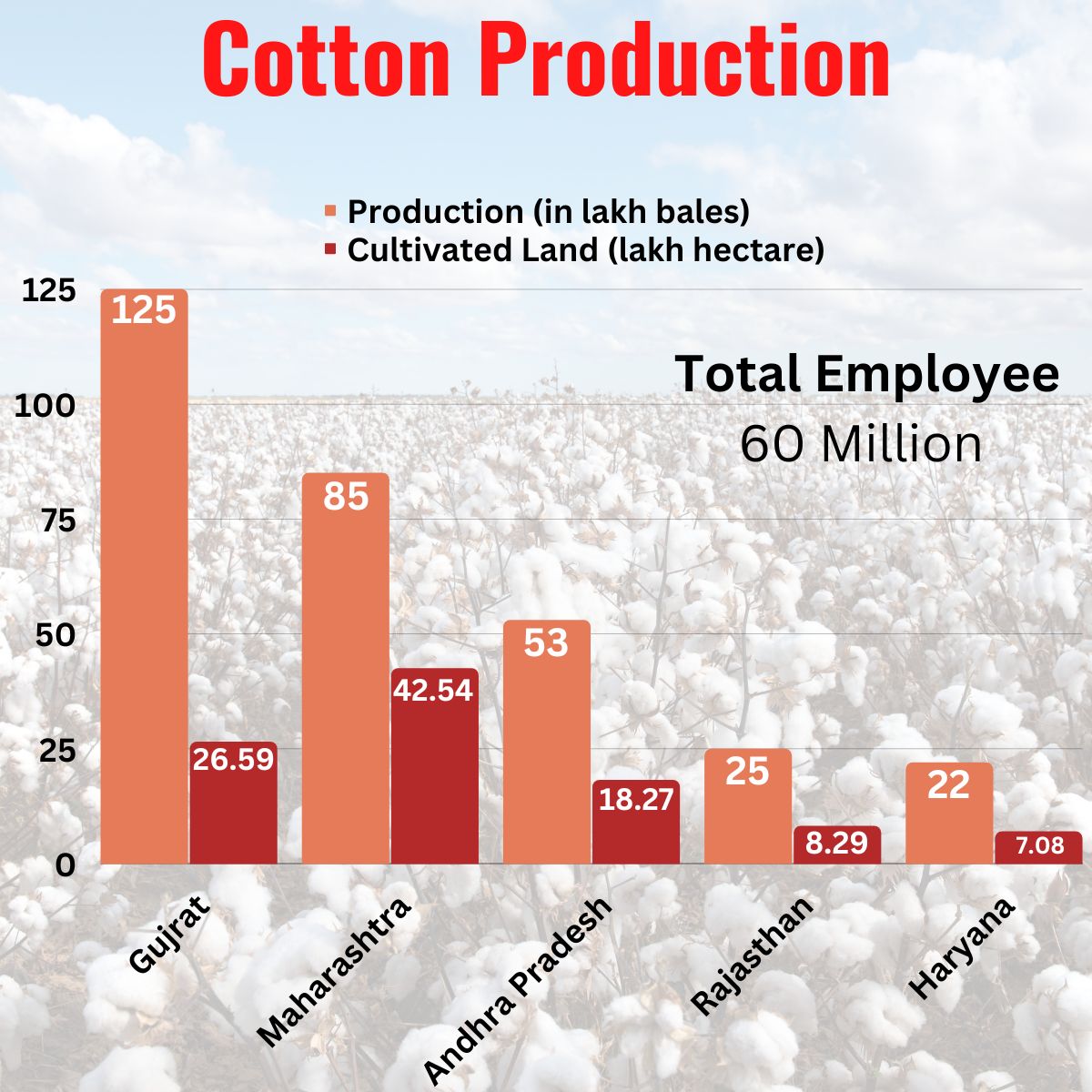
Gujarat accounts for 35% of all cotton produced in India, followed by Maharashtra with 21% of the country’s total production. Nearly two-thirds of India’s cotton production comes from the states of Maharashtra, Gujarat, Andhra Pradesh, and Telangana, which are collectively referred to as the “Cotton Basket of India.”
Jute
The jute industry is one of India’s oldest and best-known sectors of the economy. India is the largest producer of jute in the world, accounting for almost 70% of total production. Due to the significant local market demand, 90% of the total production of jute is often used domestically.
Known as “The Golden Fiber of India,” jute is primarily composed of cellulose, and lignin is the strongest fiber due to its high tensile strength.
With around 70 jute mills, about 3.5 lakh people are employed in the sector, including those who depend on the jute industry’s forward and backward linkages. 800,000 hectares of land are typically used for the cultivation of raw jute.
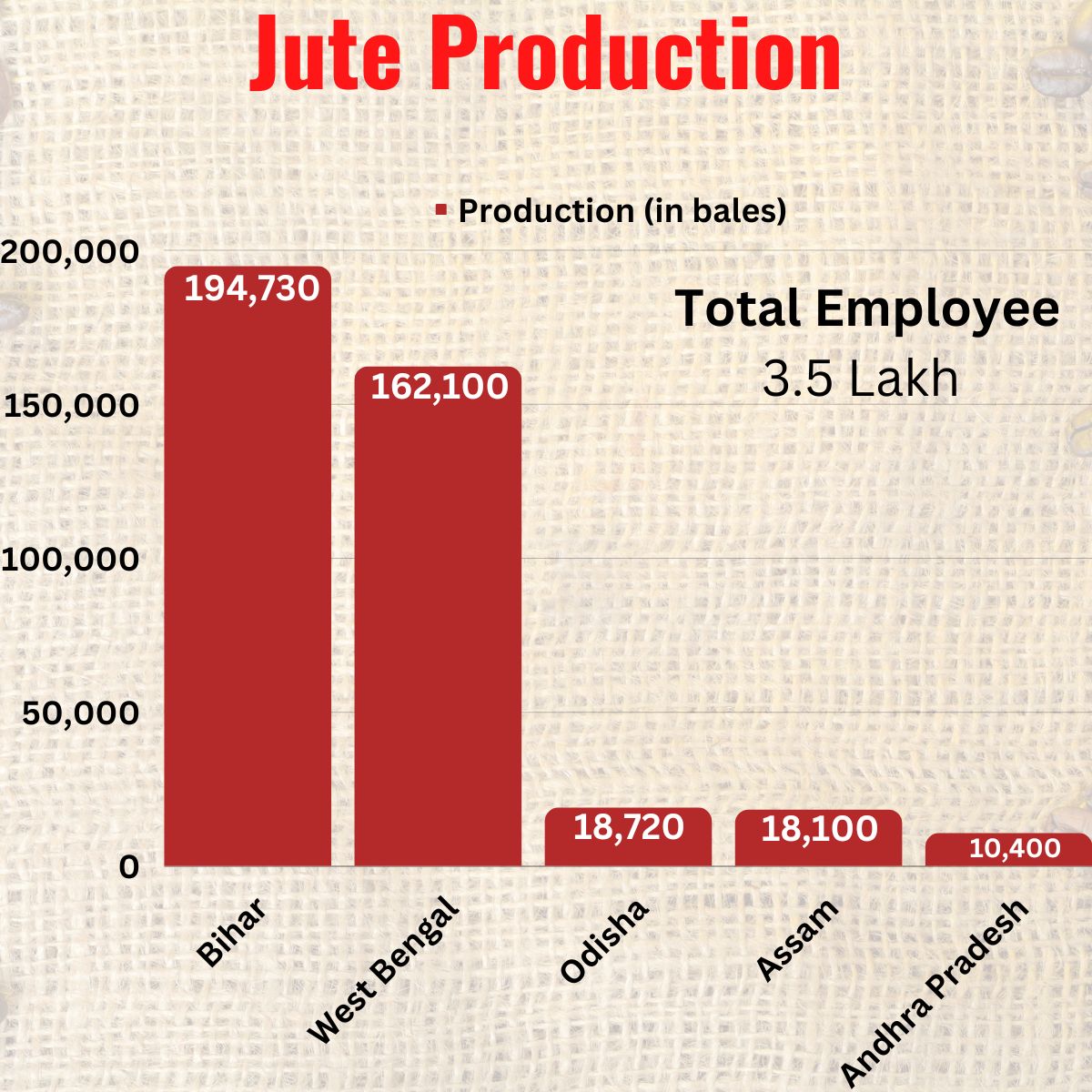
Bihar and West Bengal are the two major producers of jute. Bihar took over West Bengal as the largest producer of raw jute in India, accounting for roughly 45% of total production. West Bengal stands in second place with 162 thousand bales. Bihar and West Bengal combined account for 82% of total jute production.
Silk
Silk is a natural protein fiber, some forms of which can be woven into textiles. The word “silk” originates from Old English “sioloc“, from Latin “siliqua“, meaning “silkworm“. Silk was originally made entirely from silkworm cocoons.
India has a long and incredible history of making silk, with evidence extending back to the cities of Harappa and Mohenjo-daro more than 4,000 years ago, introduced by Chinese traders.
India is the world’s second-largest producer of silk, producing around 17% of total global production after China, which is the largest producer of silk, accounting for around 74% of global raw silk production. Around 9.76 million people are employed by the nation’s sericulture sector in rural and semi-urban areas. The sector contributes significantly to the nation’s foreign exchange earnings. 52,360 villages in India are home to sericulture operations.
India is the only country that produces all 5 types of silk, i.e., Mulberry, Tropical Tasar, Oak Tasar, Eri, and Munga.
The demand for silk and silk items from India is quite strong. More than 30 countries receive the country’s exports, with the United States accounting for 29% of total silk exports, followed by the United Arab Emirates (10%). China, the United Kingdom, and Australia are the other major importers, accounting for 8%, 4%, and 4% of total exports, respectively.
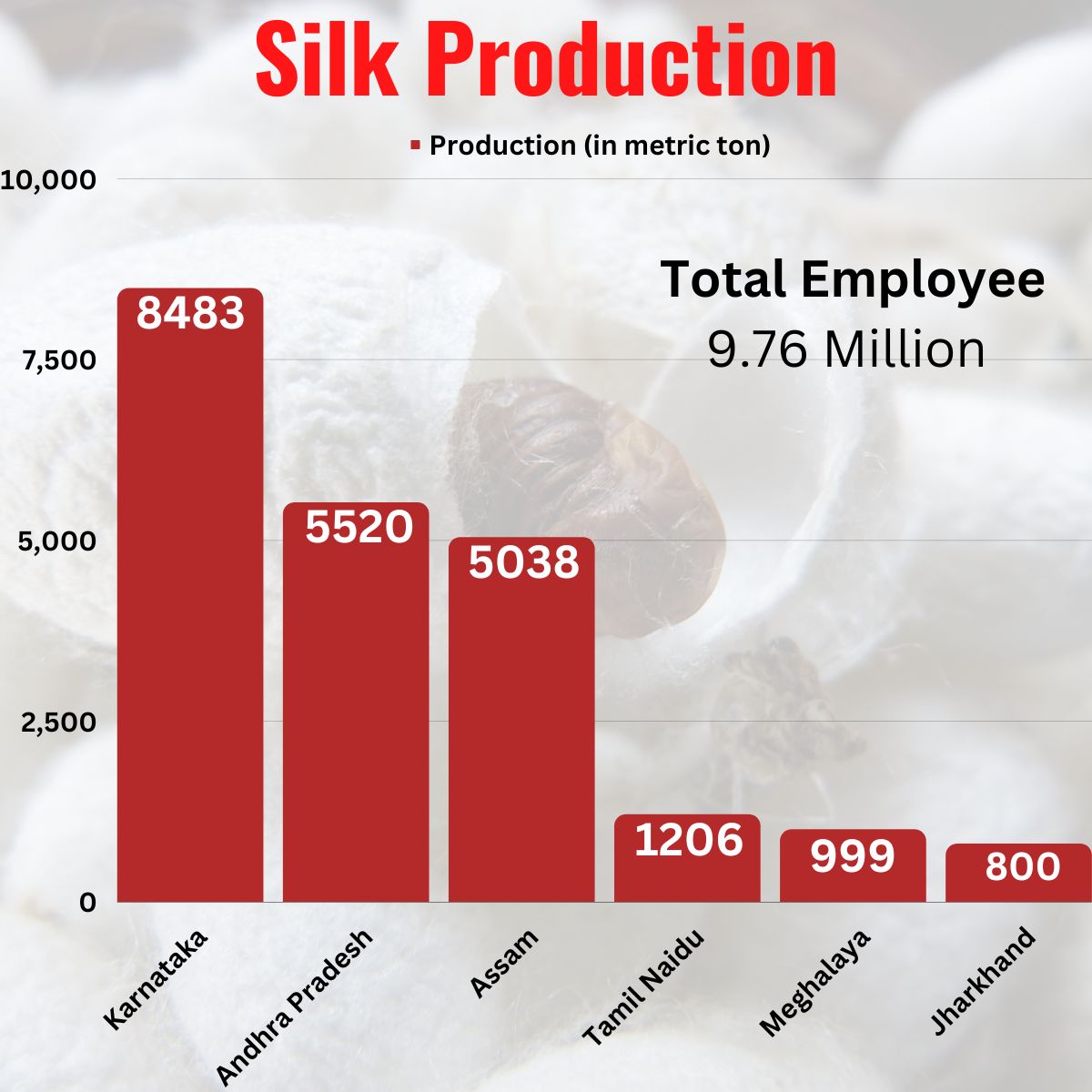
Karnataka is India’s largest silk producer, producing around 8400 metric tons of silk every year, followed by Andhra Pradesh with an average production of 5500 metric tons.
Due to their significant contributions to Indian silk manufacturing, Mysuru and North Bengaluru are known as the “Silk City.”
Wool
Wool is a natural, renewable, and biodegradable material that is highly prized for its warmth, softness, and durability.
Wool fibers are composed of a protein called keratin, which is naturally water-repellent and elastic. This makes wool fabrics resistant to wrinkling, shrinking, and stretching and gives them the ability to retain their shape and texture even after repeated washing and wearing.
Wool is also an excellent insulator, making it a popular choice for clothing, blankets, and other items that are designed to keep people warm.
India, with the third largest sheep population (74.26 million), is the ninth largest wool producer in the world, accounting for roughly 3% of total world wool production.
Wool is produced in three grades in India: carpet grade, apparel grade, and coarser grade. These groups account for 85%, 5%, and 10% of total production, respectively.
The Indian wool industry employs around 1.2 million people in the organized sector and approximately 2 million people in related sectors. Carpet weaving employs around 0.3 million people.
India’s wool sector is export-oriented. Carpets, ready-made clothes, woolen yarn, textiles, blankets, knitwear, tops, shoddy fabrics, and so on are the most common forms of wool items exported from India.
Woolen carpets account for the majority of woolen items exported from India. Carpets account for about 80% of all woolen items exported from India.
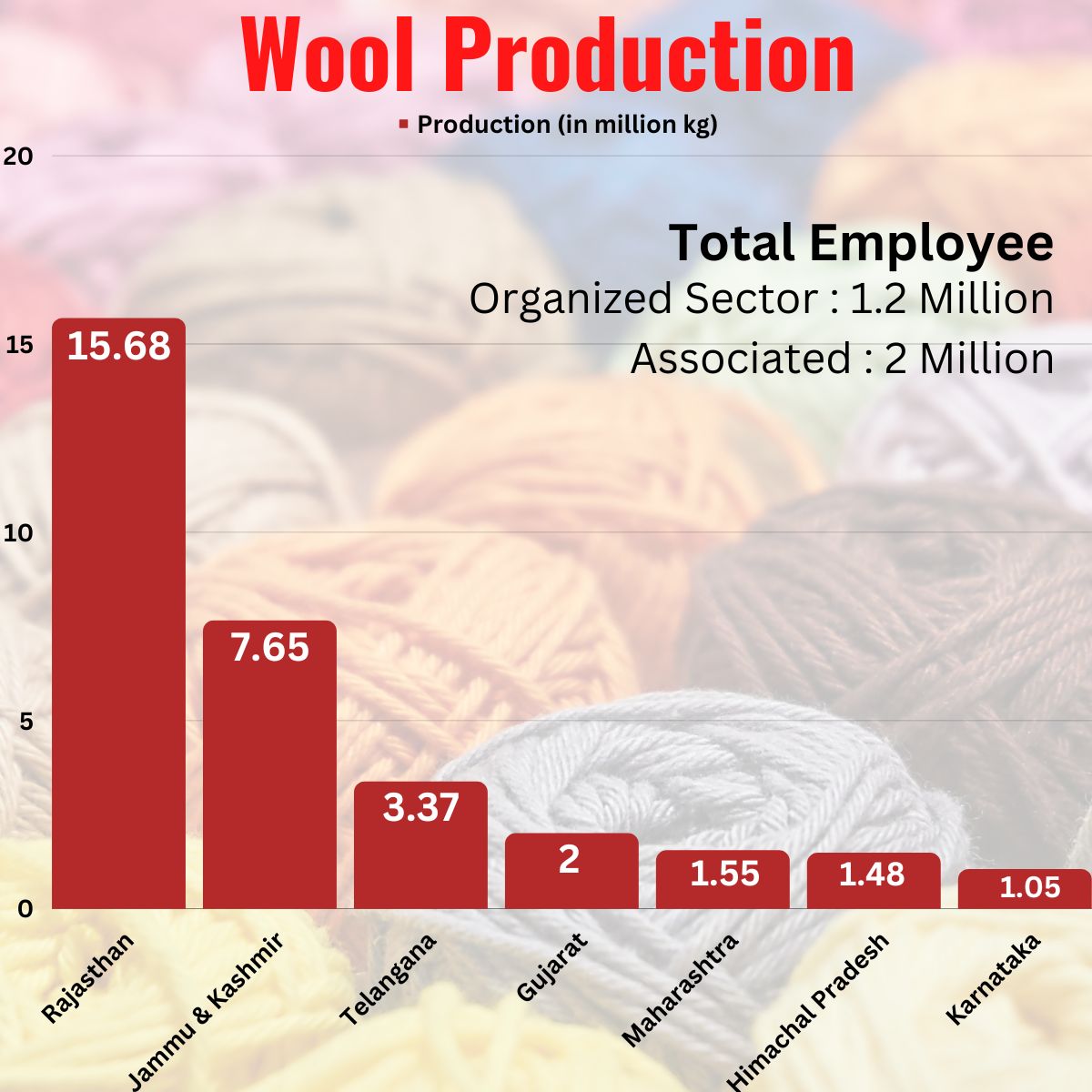
Rajasthan is the largest producer of wool, accounting for 30% of total wool production in India, followed by Karnataka, Telangana, Gujarat, Himachal Pradesh, Uttarakhand, Himachal Pradesh, Maharashtra, Uttar Pradesh, and Andhra Pradesh.
India is also known for its production of other natural fibers such as linen, ramie, and bamboo. In addition to these, India also produces a range of specialized textiles, such as hand-woven fabrics, embroidered fabrics, and traditional Indian textiles such as saris and dupattas.
Biggest Textile Industries in India
India has a large and diverse textile industry, with a large number of companies operating in the sector.
India currently homes more than 1400 large textile companies and around 1.5 million small and medium enterprises (SMEs) operating in the sector.
Here are the top 10 textile companies in India based on their annual revenue:
- Arvind Limited: This company is a leading player in the textile industry and has a presence across the entire value chain, from spinning, weaving, and knitting to processing, finishing, and retailing.
- Raymond Limited: Raymond is a leading textile company in India and is known for its high-quality fabrics and fashion products.
- Aditya Birla Group: The Aditya Birla Group is a multinational conglomerate with interests in a wide range of industries, including textiles. The group has a significant presence in the textile industry through its brands, such as Grasim, VSF, and Birla Century.
- Reliance Industries Limited: Reliance Industries is a major player in the textile industry in India, with a presence across the entire value chain. The company has a strong focus on research and development and is known for its innovative products.
- LNJ Bhilwara Group: The LNJ Bhilwara Group is a leading textile company in India and has a significant presence in the domestic and international markets. The group has a wide range of products, including cotton, synthetic, and blended yarns.
- Alok Industries Limited: Alok Industries is a leading textile company in India and has a presence across the entire value chain, from spinning and weaving to processing and finishing. The company has a strong focus on sustainability and is known for its eco-friendly products.
- Bombay Dyeing: Bombay Dyeing is a leading textile company in India and is known for its high-quality fabrics and home textiles.
- Welspun Group: The Welspun Group is a leading player in the textile industry in India and has a significant presence in the domestic and international markets.
- S Kumars Nationwide: S Kumars Nationwide is a leading textile company in India and has a wide range of products, including cotton, synthetic, and blended yarns.
- Trident Limited: Trident is a leading textile company in India and has a presence across the entire value chain, from spinning and weaving to processing and finishing. The company has a strong focus on sustainability and is known for its eco-friendly products.
Overall, the diversity and variety of textiles produced in India make it a major player in the global textile industry.
Textile Industry is an ever growing industry with revolutionary advancements happening concurrently. To know about the trends and innovations which are going to reform the industry, visit GARTEX Texprocess India 2023.
More News
Rural India’s Design Labs: Where Craft Meets Contemporary
The overlooked rise of design innovation beyond urban India In the vast, textured fabric of India's garment and fashion industry, the story…View More
India’s Evolving Role in Global Apparel Supply Chains
In the last few years, global apparel supply chains have been tested like never before. From pandemic-related disruptions to rising geopolitical tensions…View More
Quality Control in Garment Manufacturing: What’s Changing in 2025?
In 2025, garment manufacturing is entering a new era—one defined not only by speed and scale, but by precision, consistency, and sustainability.…View More
How to Identify Authentic Indian Handloom Products?
Indian handloom products are a timeless testament to the country’s rich cultural heritage and craftsmanship. From luxurious Banarasi silks to timeless Khadi…View More
How to Start a Garment Manufacturing Business in India?
India’s textile and garment industry has always been a major contributor to the country’s economy, offering vast opportunities for entrepreneurs. With the…View More
Download
Register Now
Recent Posts
Show Countdown
DELHI
Bharat Mandapam (Pragati Maidan), New Delhi, India
- days
- Hours
- Minutes
- Seconds
MUMBAI
Bombay Exhibition Center, Mumbai


